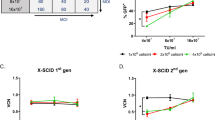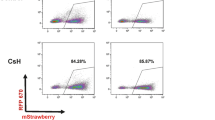Abstract
Efficient transduction of hematopoietic stem cells is a prerequisite for successful hematopoietic stem cell gene therapy. Oncoretroviral vectors are the most widely used vectors for hematopoietic gene therapy studies. However, these vectors require cell division, and thus efficient transduction of quiescent stem cells has been difficult to achieve. Lentiviral vectors can transduce non-dividing cells and therefore may be more efficient in transducing quiescent hematopoietic stem cells. We have used a competitive repopulation assay in the baboon to compare transduction of hematopoietic repopulating cells by lentiviral and oncoretroviral vectors. Baboon CD34-enriched marrow cells were transduced in the presence or absence of multiple hematopoietic growth factors using a short, 2-day, transduction protocol. Here, we show that efficient lentiviral transduction of hematopoietic repopulating cells was only achieved when cells were transduced in the presence of multiple growth factors. Using these conditions, up to 8.6% of hematopoietic repopulating cells were genetically modified by the lentiviral vector more than 1 year after transplant. Interestingly, the number of lentivirally marked cells increased over time in three of four animals. In conclusion, these results suggest that lentiviral vectors are able to tranduce multilineage hematopoietic stem cells, and thus, may provide an alternative vector system for clinical stem cell gene therapy applications.
This is a preview of subscription content, access via your institution
Access options
Subscribe to this journal
Receive 12 print issues and online access
$259.00 per year
only $21.58 per issue
Buy this article
- Purchase on Springer Link
- Instant access to full article PDF
Prices may be subject to local taxes which are calculated during checkout





Similar content being viewed by others
References
Jones RJ et al. Separation of pluripotent haematopoietic stem cells from spleen colony-forming cells Nature 1990 347: 188–189
Miller DG, Adam MA, Miller AD . Gene transfer by retrovirus vectors occurs only in cells that are actively replicating at the time of infection Mol Cell Biol 1990 10: 4239–4242
Roe T, Reynolds TC, Yu G, Brown PO . Integration of murine leukemia virus DNA depends on mitosis EMBO J 1993 12: 2099–2108
Nolta JA, Kohn DB . Comparison of the effects of growth factors on retroviral vector-mediated gene transfer and the proliferative status of human hematopoietic progenitor cells Hum Gene Ther 1990 1: 257–268
Luskey BD, Rosenblatt M, Zsebo K, Williams DA . Stem cell factor, interleukin-3, and interleukin-6 promote retroviral-mediated gene transfer into murine hematopoietic stem cells Blood 1992 80: 396–402
Bodine DM, Karlsson S, Nienhuis AW . Combination of interleukins 3 and 6 preserves stem cell function in culture and enhances retrovirus-mediated gene transfer into hematopoietic stem cells Proc Natl Acad Sci USA 1989 86: 8897–8901
Jordan CT, Yamasaki G, Minamoto D . High-resolution cell cycle analysis of defined phenotypic subsets within primitive human hematopoietic cell populations Exp Hematol 1996 24: 1347–1355
Tisdale JF et al. Ex vivo expansion of genetically marked Rhesus peripheral blood progenitor cells results in diminished long-term repopulating ability Blood 1998 92: 1131–1141
Naldini L et al. In vivo gene delivery and stable transduction of nondividing cells by a lentiviral vector Science 1996 272: 263–267
Lewis PF, Emerman M . Passage through mitosis is required for oncoretroviruses but not for the human immunodeficiency virus J Virol 1994 68: 510–516
Mikkola H et al. Lentivirus gene transfer in murine hematopoietic progenitor cells is compromised by a delay in proviral integration and results in transduction mosaicism and heterogeneous gene expression in progeny cells J Virol 2000 74: 11911–11918
Kiem H-P et al. Gene transfer into marrow repopulating cells: comparison between amphotropic and gibbon ape leukemia virus pseudotyped retroviral vectors in a competitive repopulation assay in baboons Blood 1997 90: 4638–4645
Kiem H-P et al. Improved gene transfer into baboon marrow repopulating cells using recombinant human fibronectin fragment CH-296 in combination with interleukin-6, stem cell factor, FLT-3 ligand, and megakaryocyte growth and development factor Blood 1998 92: 1878–1886
Kurre P et al. Gene transfer into baboon repopulating cells: a comparison of flt-3 ligand and megakaryocyte growth and development factor versus IL-3 during ex vivo transduction Mol Ther 2001 3: 920–927
Huhn RD et al. Retroviral marking and transplantation of rhesus hematopoietic cells by nonmyeloablative conditioning Hum Gene Ther 1999 10: 1783–1790
Dunbar CE . The use of nonhuman primate models to improve gene transfer into haematopoietic stem cells (review) J Intern Med 2001 249: 329–338
Follenzi A et al. Gene transfer by lentiviral vectors is limited by nuclear translocation and rescued by HIV-1 pol sequences Nat Genet 2000 25: 217–222
Goerner M et al. Sustained multilineage gene persistence and expression in dogs transplanted with CD34+ marrow cells transduced by RD114-pseudotype oncoretrovirus vectors Blood 2001 98: 2065–2070
Donahue RE et al. High levels of lymphoid expression of enhanced green fluorescent protein in nonhuman primates transplanted with cytokine-mobilized peripheral blood CD34(+) cells Blood 2000 95: 445–452
Miyoshi H et al. Transduction of human CD34+ cells that mediate long-term engraftment of NOD/SCID mice by HIV vectors Science 1999 283: 682–686
An DS et al. Marking and gene expression by a lentivirus vector in transplanted human and nonhuman primate CD34(+) cells J Virol 2000 74: 1286–1295
An DS et al. Lentivirus vector-mediated hematopoietic stem cell gene transfer of common gamma-chain cytokine receptor in rhesus macaques J Virol 2001 75: 3547–3555
Zack JA et al. HIV-1 entry into quiescent primary lymphocytes: molecular analysis reveals a labile, latent viral structure Cell 1990 61: 213–222
Chou CS, Ramilo O, Vitetta ES . Highly purified CD25-resting T cells cannot be infected de novo with HIV-1 Proc Natl Acad Sci USA 1997 94: 1361–1365
Korin YD, Zack JA . Nonproductive human immunodeficiency virus type 1 infection in nucleoside-treated G0 lymphocytes J Virol 1999 73: 6526–6532
Unutmaz D, KewalRamani VN, Marmon S, Littman DR . Cytokine signals are sufficient for HIV-1 infection of resting human T lymphocytes J Exp Med 1999 189: 1735–1746
Kiem H-P et al. Improved gene transfer into canine hematopoietic repopulating cells using CD34-enriched marrow cells in combination with a gibbon ape leukemia virus-pseudotype retroviral vector Gene Therapy 1999 6: 966–972
von Laer D et al. Amphotropic and VSV-G-pseudotyped retroviral vectors transduce human hematopoietic progenitor cells with similar efficiency Bone Marrow Transplant 2000 26: S75–S79
Gallardo HF, Tan C, Ory D, Sadelain M . Recombinant retroviruses pseudotyped with the vesicular stomatitis virus G glycoprotein mediate both stable gene transfer and pseudotransduction in human peripheral blood lymphocytes Blood 1997 90: 952–957
Shi PA et al. Comparison in the rhesus monkey of in vivo gene marking with amphotrophic and VSV-G pseudotyped retroviral vectors Blood 2001 98: 209a
Schmidt M et al. Detection and direct genomic sequencing of multiple rare unknown flanking DNA in highly complex samples Hum Gene Ther 2001 12: 743–749
Kohn DB et al. Engraftment of gene-modified umbilical cord blood cells in neonates with adenosine deaminase deficiency Nat Med 1995 1: 1017–1023
Nolta JA et al. Transduction of pluripotent human hematopoietic stem cells demonstrated by clonal analysis after engraftment in immune-deficient mice Proc Natl Acad Sci USA 1996 93: 2414–2419
Guenechea G, Gan OI, Dorrell C, Dick JE . Distinct classes of human stem cells that differ in proliferative and self-renewal potential Nat Immunol 2001 2: 75–82
Miller AD, Rosman GJ . Improved retroviral vectors for gene transfer and expression Biotechniques 1989 7: 980–982
Zufferey R, Donello JE, Trono D, Hope TJ . Woodchuck hepatitis virus posttranscriptional regulatory element enhances expression of transgenes delivered by retroviral vectors J Virol 1999 73: 2886–2892
Zufferey R et al. Multiply attenuated lentiviral vector achieves efficient gene delivery in vivo Nat Biotechnol 1997 15: 871–875
Hanenberg H et al. Colocalization of retrovirus and target cells on specific fibronectin fragments increases genetic transduction of mammalian cells Nat Med 1996 2: 876–882
Heid CA, Stevens J, Livak KJ, Williams PM . Real time quantitative PCR Genome Res 1996 6: 986–994
Acknowledgements
The authors wish to thank Melissa C Richman, Laura J Peterson, and Jennifer Potter for their technical assistance, Mike Gough and the staff of the University of Washington Regional Primate Research Center for assistance with the animals, as well as Bonnie Larson and Helen Crawford for their help in preparing the manuscript. This work was supported in part by NIH grants HL54881, HL53750, DK47754, DK56465, and RR00166. PAH is supported by the German Krebshilfe. H-PK is a Markey Molecular Medicine Investigator.
Author information
Authors and Affiliations
Rights and permissions
About this article
Cite this article
Horn, P., Morris, J., Bukovsky, A. et al. Lentivirus-mediated gene transfer into hematopoietic repopulating cells in baboons. Gene Ther 9, 1464–1471 (2002). https://doi.org/10.1038/sj.gt.3301820
Received:
Accepted:
Published:
Issue Date:
DOI: https://doi.org/10.1038/sj.gt.3301820
Keywords
This article is cited by
-
Mechanistic Basis of ex Vivo Umbilical Cord Blood Stem Progenitor Cell Expansion
Stem Cell Reviews and Reports (2020)
-
Expansion of hematopoietic stem cells for transplantation: current perspectives
Experimental Hematology & Oncology (2012)
-
Gene therapy to inhibit xenoantibody production using lentiviral vectors in non-human primates
Gene Therapy (2007)
-
Lentiviral vector conferring resistance to mycophenolate mofetil and sensitivity to ganciclovir for in vivo T-cell selection
Gene Therapy (2007)
-
Hematopoietic stem cell gene therapy of murine protoporphyria by methylguanine-DNA-methyltransferase-mediated in vivo drug selection
Gene Therapy (2004)



